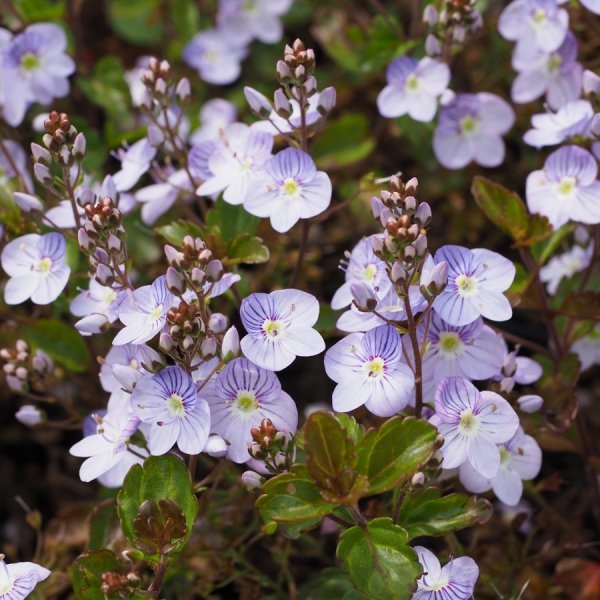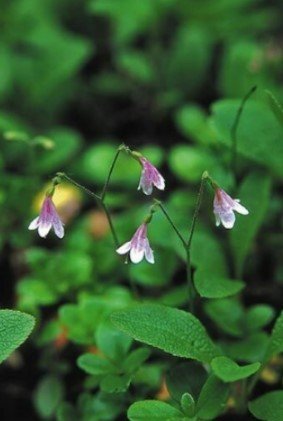These filters work on “and” logic, so adding more types or qualities will further filter the list to plants that have ALL of the types or qualities selected.
This graceful evergreen fern is an excellent addition to a part- or full-shade woodland garden that has humus-rich soils.
Its lower, lush fronds are evergreen and sterile; its fertile fronds emerge from the center and stand erect, resembling delicate black combs. In the right conditions, this is one of our most stunning native ferns!
Typically reaches 2 ft. (up to 3 ft. in moister conditions). Plant in shade, top dress with compost and/or wood-chip mulch.
Well known for primarily growing with mosses on rotting logs or in deciduous trees, it will also colonize on the ground and naturalizes beautifully transplanted into these conditions. Mix with native shade-loving perennials for best effect!
The fronds emerge singly, up to 12 in. long, but in bunches, creating a carpet of ferns during the winter when they're at their peak. This fern comes to life from fall until summer with triangular fronds. Its natural cycle is to go drought-dormant in summer, so plant it with summer-blooming perennials such as Inside-out Flower and Foam Flower that mask its dormant leaves, allowing it to fill the space for the rest of the year.
Best transplanted into an area that already favors moss or has humus-rich soils, shade, and is close enough to your hose to receive a little water until it is established and begins to colonize.
This PNW native honeysuckle features stunning pink-purple flowers in spring and summer, followed by attractive red berries in the fall, attracting birds. The foliage is semi-evergreen and covered in small hairs — thus the origin of one of its common names.
This honeysuckles presents as a loose-growing vine or groundcover, frequently found on bluffs above marine shorelines, and making it a super revegetation plant for preventing surface erosion. It can spread 3-20 ft. as a climber, but more typically in groundcover form, depending on conditions.
Great for pollinators and native songbirds.
A highly flexible plant, can thrive equally in sun to shade, and most soils (even clay) as long as the drainage is adequate. Drought tolerant once established.
With a long blooming cycle, potentially spring through fall, this sweet, mat-forming perennial groundcover spreads 12-15 in. per plant, but only 3-5 in. high.
It features lavender-blue flowers and semi-glossy (and semi-evergreen) bronze-green leaves. Extend the bloom cycle by shearing back after the spring bounty of flowers.
Terrific planted between pavers, to define a border, or in a rock garden. Grows best in sun to partial shade in well-draining soil. Terrific for pollinators!
This Veronica is valued as a groundcover for various site conditions, including filling in between widely spaced stepping stones or edging a border.
Indigo/purple flowers with white eyes, and lush deep green glossy foliage bloom in early-late spring. Shear them back to prolog the bloom period. The indigo flowers attracts hummingbirds and butterflies!
Grows to 6 to 8 inches tall and spreads to form a carpet. Needs full sun to part shade and does well in most soil types.
A great option as a "steppable" groundcover between stepping stones & stone stairways, this drought-tolerant evergreen thyme spreads to cover your space and features seasonal rosy-reddish flowers. Spreads about a foot over time. This variety is not as low or tight in appearance as Elfin. Plant 8-12" apart, closer for faster coverage. Best in well-drained soil and full sun.
This hardy mat-forming evergreen groundcover features tiny white flowers that cover the dark green glossy foliage from late spring to late summer. The foliage turns wine and bronze shades in the colder months
With a tidy habit and a maximum 6 in. height by 12-18 in. spread, this is perfect as an evergreen groundcover, to define the front of the border or a pathway, or for a rock garden.
Like most cinquefoils, this one also prefers full sun in a well drained soil and is drought tolerant once established.
Oregon Oxalis features three heart-shaped leaflets on each leaf and one white or rose-pink flower at the end of each stalk, blooming April to September.
This semi-evergreen to deciduous herbaceous perennial grows 6-8 in. high and requires full to partial shade as well as humus-rich soil.
Oxalis makes a lovely groundcover, especially mixed with other woodland species such as violets, Wild Ginger, Tiarella or Tellima, or any of the other native shade-loving perennials you can find by searching this sale’s categories.
Twinflower is a splendid PNW woodland native evergreen groundcover-like perennial, with long trailing stems and charming ''twin'' flowers. The tiny oppositely-arranged leaves are glossy and dark green - the perfect backdrop for the delicately fragrant, pale-pink bell-shaped flowers in nodding pairs at the end of 4-6" stalks.
Prized for its evergreen foliage and its more delicate spreading habit, which permits plenty of other PNW shade-loving perennials to share the space!
Linnaea takes its name from the famous botanist, Linnaeus (1707-1778), who is commonly referred to as the ''father of taxonomy.''










A rarely seen fern of our lowland Salish Sea region, found in mixed conifer or conifer-hardwood forests, often near stream edges, springs, or seeps along rocky outcrops. (In Thurston County, keep an eye out to encounter them in sections of Burfoot County Park!)
While having the feathery appearance of a deciduous fern such as Lady-fern, the large, graceful fronds of Woodwardia are actually evergreen, arising from a stout base where many fronds emerge in a tight cluster. Considered the largest native fern in North America, fronds can grow 3+ feet long, and over time a Woodwardia fern can be 4 ft. or more high and wide, though they usually top out ~3x3 ft. in our area.
Given its native habitat near moisture, this fern will do best if given a little supplemental irrigation in summer, though it may also slip into semi-dormancy in summer, similar to licorice ferns. Siting this evergreen fern adjacent to your birdbath is a great way to give year-round cover to your songbirds while also ensuring this fern does not get too thirsty. As with most ferns, site this in full to partial shade, with hummus-rich soil and woodchip mulch on top. Naturally deer and rabbit resistant!